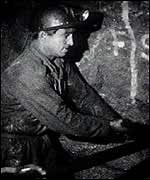|
At one time
Cornwall boasted 2,000 tin mines and it was a world leader in tin production.
Foreign
competition was to change all that. Competitors overseas were producing
ores far more cheaply than Cornwall.
 |
|
Cornish tin miners faced increasing
competition from alluvial mines abroad |
Prices for
tin plummeted and dropped below the cost of production.
In the past,
Cornwall had survived increasing competition from the Dutch in 1816, largely
thanks to the abolition of the 7% duty charged on smelted tin, known as
coinage dues.
But in 1872,
tin was discovered in Queensland, New South Wales and Tasmania. Tin fever
swept Australia.
Renewed
competition from Malaya and Bolivia was the final nail in the coffin and
between 1871 and 1881 it is estimated that a third of Cornwall's mining
population emigrated in the face of unbearable hardship at home.
A long
way down
Within half
a century of the tin boom of 1870-72, the industry was almost dead in
the face of foreign competition.
Only the
demand for tin in the two World Wars postponed the slow decline.
 |
|
Working
underground |
A handful
of mines survived, largely through amalgamation - South Crofty in Camborne,
was one of them.
During the
20th Century, the tin mining industry careered from boom to bust, with
boom experienced during the war years, firmly countered by the bust of
the 1930s.
Bitter disputes
and strikes ensued during the depression and in South Crofty mine, this
came to a head in 1939.
A row of
differential pay rates resulted in a strike which pitched miner against
miner, family against family and only ended with the start of the Second
World War and subsequent greater demand for tin.
By 1960
South Crofty had control of nearly six square miles. Demand was high,
wages were good, but there was a shortage of men prepared to work underground.
Yet again,
the changing fortunes of the industry were short lived and miners found
themselves facing redundancy once more.
Although
various ores became briefly profitable during the 20th Century, they were
unsustainable and on March 6, 1998 the pumps at South Crofty, the UK's
last tin mine, were finally turned off for good.
Ray of
hope
 |
|
End
of the line for tin |
It spelt
the end not only of a 4,000 year old regional industry, responsible for
most of the world's tin in the last century, but also the last tin mine
in Europe.
Tin mining
in Cornwall may be over but this it not necessarily the end of the story
for the industry steeped in thousand of years of history.
A bid is
being made to have Cornwall's tin mining areas designated a World Heritage
Site.
If the bid
is successful, the region's industrial remains would rank alongside world
treasures such as Venice and Stonehenge and ensure that one of Britain's
oldest industries doesn't vanish into the annals of history.
|

